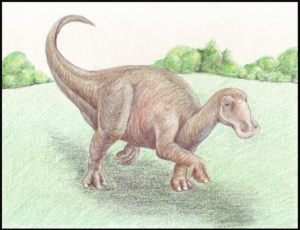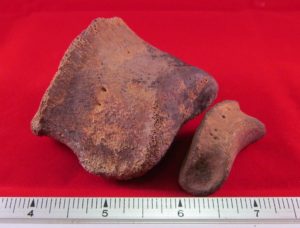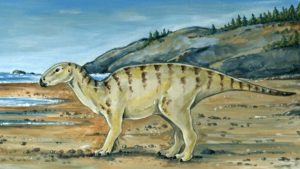THE CREATION IS ENGINEERED – NOT EVOLVED!
In November 2018, University of Oregon paleontologists announced that they had found a fossil dinosaur toe bone in Oregon. The traditional view has been that there were no dinosaur bones in Oregon because, according to the secular paradigm, Oregon was under water during the Mesozoic Era. That is the era in the secular geologic timeline when the dinosaurs lived.
In this article I will provide some insight concerning the significance of this find from a biblical creationist perspective.
Here are the salient facts as reported (should I say “hyped”?) by numerous news articles throughout Oregon and elsewhere:
1. What was found? A single fossil toe bone. I concur that it looks like a fossil Duck-Billed dinosaur toe bone, albeit not a particularly good example of one. See below the U of O photo showing three views of the Oregon bone and, below that image, a similar toe bone (the smaller one at right) from my fossil collection from an Edmontosaurus Duck-Billed kind of dinosaur. My fossil toe bone is from the Lance Creek formation of Wyoming.
2. How big is the toe bone? The Oregon bone is one inch long and less than two inches wide. That is the same width as the Edmontosaurus bone shown and slightly longer than my fossil which is 3/4″ long. The photo below this paragraph shows a complete reconstructed Edmontosaurus foot. The toe bones are scientifically called “phalanges.”
3. Where was the bone found? It was discovered in 2015 in the Hudspeth geologic formation in Oregon not far from the small town of Mitchell, Oregon. The announcement describes the location as being on U.S. Bureau of Land Management property not far from the Painted Hills in the John Day Fossil Beds National Monument. For my detailed discussion of the Hudspeth formation regarding the “Mitchell Plesiosaur,” see my book, Discovering the Animals of Ancient Oregon, pages 236-244.
4. How was the toe bone found? The discoverer, University of Oregon professor Greg Retallack, was looking for ammonite fossils. He was quoted as saying, “No excavation was needed. It was just sitting among the ammonites and coil fossils.”
5. How was the bone identified? It was identified by comparing it to other dinosaur bones. Retallack says he visited museums from Montana to Alaska and Canada, examining fossilized dinosaur collections to weigh their characteristics against his find.
So, there are the facts. Next let’s look at the interpretations that have been made about the bone through the news media:
1. How old is the bone? According to the news articles the bone “dates back to 103 million years to the Cretaceous, a geological period that also gave rise to Tyrannosaurus rex.”
2. What kind of dinosaur did the toe bone come from? “The toe bone belonged to a plant-eating, bipedal dinosaur known as an ornithopod.” On television news I heard Retallack say it was like the Iguanodon dinosaur. See below the images provided by the news outlets.
3. How big was the dinosaur? The news article estimate was given as “more than 20 feet long and weighed nearly a ton.”
4. Where was information about the fossil scientifically published? It was published in the evolutionist Journal of Vertebrate Paleontology which declared, “The toe bone was the first diagnostic non avian dinosaur fossil from Oregon, a state whose Mesozoic rocks are mostly marine. This discovery is novel evidence of Cretaceous terrestrial environments and faunas in Oregon.”
5. How did the bone come to be in Oregon? Paper co-author, Edward Davis, was quoted as saying, “The most likely scenario is the ornithopod died on the shore, washed out to sea and burst after filling up with decompositions gases. The toe bone fossilized over millions of years.” Davis was also quoted as saying, “The phenomenon is sometimes called ‘bloat and float.’ That is, the animal died on the shore its terrestrial habitat, then washed out to sea, where it floated while bloated with decomposition gases. Eventually it burst, and only this toe was entombed and became a fossil.”
So we have a list of five facts and another list of five interpretations. Whether the interpretations are in all cases meant by the reseachers to be stated as facts cannot be entirely known from the reports, but they are usually provided by the media to the public as facts. With a little critical thinking we will be able to see that the interpretations are really just stated as facts and would be better described as speculative stories or even fairly tales.
Interpretation #1: “The bone is 103 million years old.” I have spent most of my ministry, at least since 2004, writing and speaking on this topic. All of my books and many of my articles and presentations point out that the concept of “millions of years” is an evolutionary presupposition developed by men in order to reject the biblical account of origins. The biblical history cannot support a time span since the creation of any more than 7,000 years, and all Biology, Geology and Paleontology can be easily interpreted within the creationist view. I have shown numerous times that the secular Geologic Timeline is simply a mental abstraction not based on any true science.
I find it interesting, too, that the wording, “a geological period that also gave rise to Tyrannosaurus rex“ was used. This matches to the evolutionist idea that life can pop out of rocks or pond scum when it is scientifically known (The Law of Biogenesis) that life can only come from life. Of course, a period of time does not scientifically “give rise” to anything nor can nature “select” anything. All true science screams intelligent Designer not stupid nature.
Interpretation #2: “The dinosaur was an ornithopod perhaps like the Iguanodon.” In my book Guidebook to North American Dinosaurs According to Created Kinds, I have developed the hypothesis that there were only about 15 created kinds of North American dinosaurs. This is at odds with the evolutionary view that there are hundreds of different kinds (say genera or families) of dinosaurs, many of which are in the group identified as Ornithopods. I do give the University of Oregon researchers great credit for not trying to identify or name the dinosaur at the genus level. In my experience this is unusual and many vertebrate animals have been given names with the evidence of only a bone or two. As paleontologist Jack Horner of the Museum of the Rockies has said, “Scientists like to name things.” Of course the reason for that is that by applying new species and genus names to dead living things they gain the recognition they need to professionally exist in their fields of endeavor.
I am not aware of anyone finding any fossil evidence in North America for a Duck-Billed kind of dinosaur that has been identified with the genus name Iguanodon. The dinosaur Iguanodon is from Europe and initially found in Belgian sediments. The Duck-Billed kind of dinosaur from my book is depicted in the image below. Some of the North American genus names I have attributed to the Duck-Billed kind in my book are Edmontosaurus, Brachylophosaurus, Corythosaurus, Hadrosaurus, Lambeosaurus and Parasaurolophus.
Image copyrighted ©2013 by J.D. Mitchell all rights reserved.
Interpretation #3: “The dinosaur was more than 20 feet long and weighed nearly a ton.” If this toe bone was indeed from a Duck-Billed dinosaur something like an Iguanodon, then it could have been about the size as estimated in the news story. However, the Duck-Billed dinosaurs had a number of phalanges of varying sizes in their feet. So, unless the researchers were able to definitely determine which phalange the bone represented, they would just be guessing how big the dinosaur was. Other scientists have estimated that Duck-Billed dinosaurs got to be up to 45 feet long. The weight of dinosaurs is even more difficult to estimate than the lengths, keeping in mind that we don’t have any dinosaurs to weigh. In conclusion, I would say that the length estimate is probably fairly close to reality for the Oregon dinosaur.
Interpretation #4: The declaration of the Journal of Vertebrate Paleontology that, “The toe bone was the first diagnostic non avian dinosaur fossil from Oregon, a state whose Mesozoic rocks are mostly marine. This discovery is novel evidence of Cretaceous environments and faunas in Oregon.”
Firstly, notice that they are holding open the popular evolutionist hypothesis that birds evolved from dinosaurs. This is a preposterous idea that makes no sense on several levels. The Bible states that birds were created on Day 5 ahead of land animals which were created on Day 6. And, fossils of many of today’s kinds of birds have been discovered with dinosaur fossils. If today’s birds and extinct dinosaurs lived together how could it be imagined that birds evolved from the dinosaurs? Also, the structures of birds and dinosaurs are so different as to require a fairy tale explanation for any kind of evolutionary relationship.
Secondly, the only way evolutionists have to try to determine how old sedimentary rocks are is through the fossils found in the rocks as correlated to their geologic timeline abstraction. So they “know” that Oregon rocks defined as Cretaceous are marine rocks because of the fossils that are found in them. While Oregon paleontologist Davis is not quite able to believe there is a possibility that dinosaurs actually lived in Oregon, it seems that the Journal of Vertebrate Paleontology is quite able to accept that based on the finding of one dinosaur toe bone.
Interpretation #5: “The Davis ‘Bloat and Float’ hypothesis for how the bone got to Oregon.”
All true science tells us that fossils like the Oregon toe bone required rapid and complete burial to become fossilized. It also demonstrates that the secular story for the fossilization of vertebrate animals is nonsense. If animals fossilized per the evolutionist stories, then we would be buried in fossils just due to the animals that have died in the last few decades. No, the only rational explanation for the fossilization of dinosaur parts is the cataclysmic action of the global Flood at the time of Noah.
How quickly bones fossilize (Here I am talking about permineralization, the process that fossilized the toe bones we are talking about in this article.) is determined by the amount and rate of infusion of minerals into the bones by the water in the sediments in which the bones are completely buried.
Experiments have shown this can happen quickly and definitely does not take millions of years.
Experiments have also shown that the ‘bloat and float’ hypothesis is not viable. What they do show is that floating dead animals (such as whales) do not end up fossilizing in the ocean bottoms. If that were true, again, the ocean bottoms should be covered in fossils, and they definitely are not.
Floating dead whale experiment-whale does not sink, even when dynamited! Animal remnant parts that do eventually make it to the bottom are consumed by sealife before they can fossilize.
I think that most secular palentologists understand that their stories of gradual fossilization of life forms due to the actions of lakes, seas and rivers are nonsense. But they know that they cannot allow for there to be any thought that the Bible’s worldwide Flood could possibly be true. For, if they allow that, their whole atheistic worldview logically collapses in a heap.
Evolutionary story for fossilization is not reality!
So, how do I think the the fossil dinosaur bone got to Oregon? I believe it was in a manner similar to the way many mammal and other fossils of Eastern and Central Oregon got to where they are. This was as a result of the actions of the global Flood of Genesis. For details on this see my book, Discovering the Animals of Ancient Oregon.
Professor Retallack has said that now that one dinosaur fossil has been found they will be keeping their eyes open for more. If more are found, it will be interesting to see what the explanation for their existence will be. I am sorry to say it won’t likely change much from the current secular story of evolution over millions of years. This is a philosophical battle over the correct interpretation of the past history of the earth, not a fight over scientific evidence.
J.D. Mitchell









